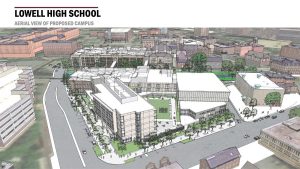 by Mary Wambui & co-edited by Mikaela Hondros-McCarthy
by Mary Wambui & co-edited by Mikaela Hondros-McCarthy
On December 5, 2022, I wrote a letter to the Lowell School Committee encouraging the City to initiate planning for a City-owned solar array on roof of the newly constructed Lowell High School.
Why this issue is important to me: I have nieces and nephews in the Lowell School system as well as children I mentor in the same school system. BIPOC students make up more than 55% of Lowell High school population. Research shows this population is disproportionately affected by asthma. The health of these children matters and that is why I decided to advocate for improved indoor air quality which can be done by removing harmful materials, weatherstripping, higher-grade MERV filter upgrades and optimizing of HVAC systems. This is an issue that affects our health care system, our pockets as taxpayers and more.
Why this issue deserves prioritization now: The high cost of energy this winter inspired me to advocate for clean and reliable energy sources for the schools as a strategy to hedge against future heating or cooling increases which will negatively impact the Lowell taxpayers. Building owners, including schools, are facing steep increases in energy costs this winter. Lowell High School which is undergoing construction has an opportunity to invest in solar panels and they should take advantage of it.
 Funding: The climate action funding landscape has shifted positively in 2022. In Massachusetts, the Baker-Polito Administration has made available $100 million in grant funding for school districts to improve ventilation and indoor air-quality to support healthy learning environments. Lowell has an allocation of about $4 million dollars from this fund. In addition, nationally the Biden-Harris Administration schools can now apply for the first round of the Renew America’s Schools grant, up to $80 million of the $500 million program, to make energy improvements especially in the highest-need districts. There is money now and the cost for inaction today will hurt schools in the future when faced with high prices or they are stuck paying for stranded gas assets as the Commonwealth migrates to all electric heating and cooling systems.
Funding: The climate action funding landscape has shifted positively in 2022. In Massachusetts, the Baker-Polito Administration has made available $100 million in grant funding for school districts to improve ventilation and indoor air-quality to support healthy learning environments. Lowell has an allocation of about $4 million dollars from this fund. In addition, nationally the Biden-Harris Administration schools can now apply for the first round of the Renew America’s Schools grant, up to $80 million of the $500 million program, to make energy improvements especially in the highest-need districts. There is money now and the cost for inaction today will hurt schools in the future when faced with high prices or they are stuck paying for stranded gas assets as the Commonwealth migrates to all electric heating and cooling systems.
Benefits to Lowell taxpayers: Energy is the second largest expense for K-12 schools. Solar investments in schools around the country from Virginia to Arkansas have reduced energy expenses and even improved teacher pay. Lowell High School will not be different. Solar at the school will reduce the risk of future energy prices volatility; a difference which taxpayers would have to fund if not taken care of today. Lowell is a city where more than 54% of residents are renters, increases in property taxes will overburden renters since landlords usually pass on such increases to renters. In Lowell, about 51% of renters are cost burdened meaning that they are paying more than 30% of their income on housing. Investing in renewables like solar will mitigate the risk of high unaffordable housing costs as well as stabilize the city’s operations.
Mary Wambui is a Lowell resident and works as an affordable housing asset manager at the Planning Office for Urban Affairs. Mary also serves as the co-chair in the Energy Equity Working Group of the Energy Efficiency Advisory Council for Massachusetts, and is an appointed member of Governor Healey’s transition policy committee on Climate















One response to “The Case for City-Owned Solar on the New LHS”
Thank you Mary and Mikaela! You make an excellent economics-based case for solarizing the LHS. There is also a strong argument to be made that Lowell can set a good example for the Merrimack Valley as meeting the challenge of climate change head-on with this project. Lowell would have a visible, 300KW solar system to model to neighboring communities. We would demonstrate how to cut green-house gas emissions and save money at the same time.